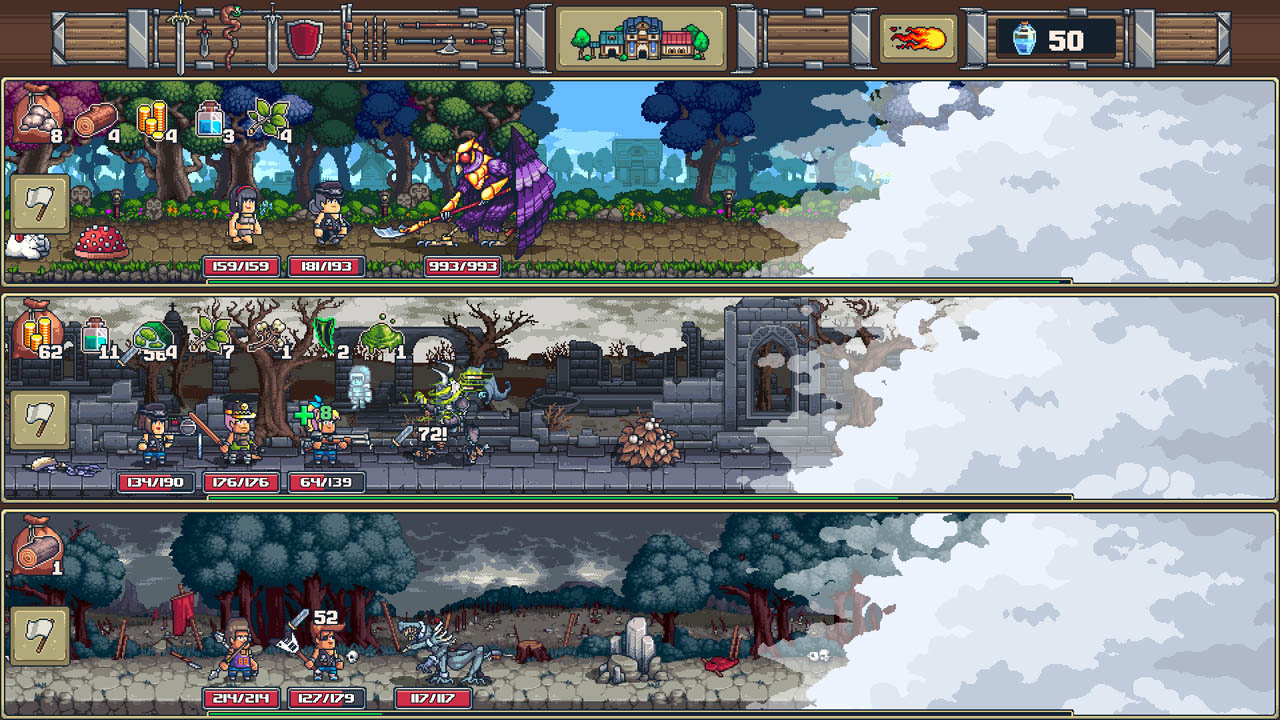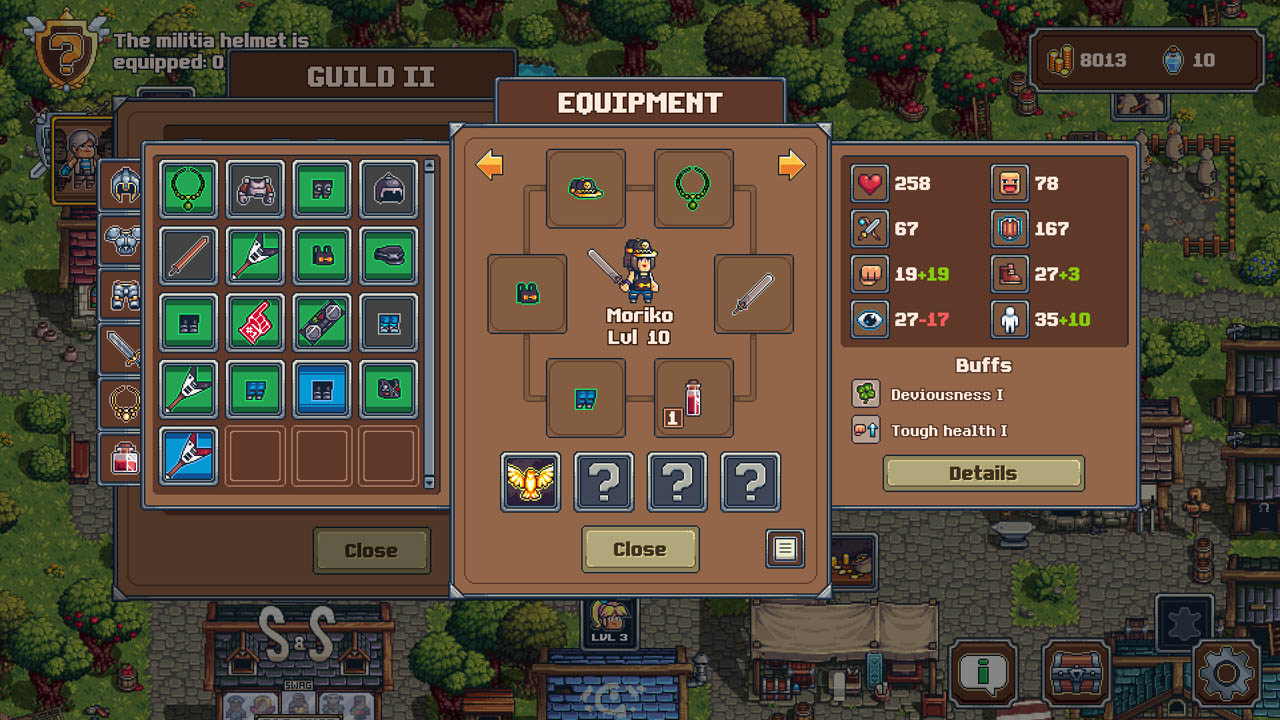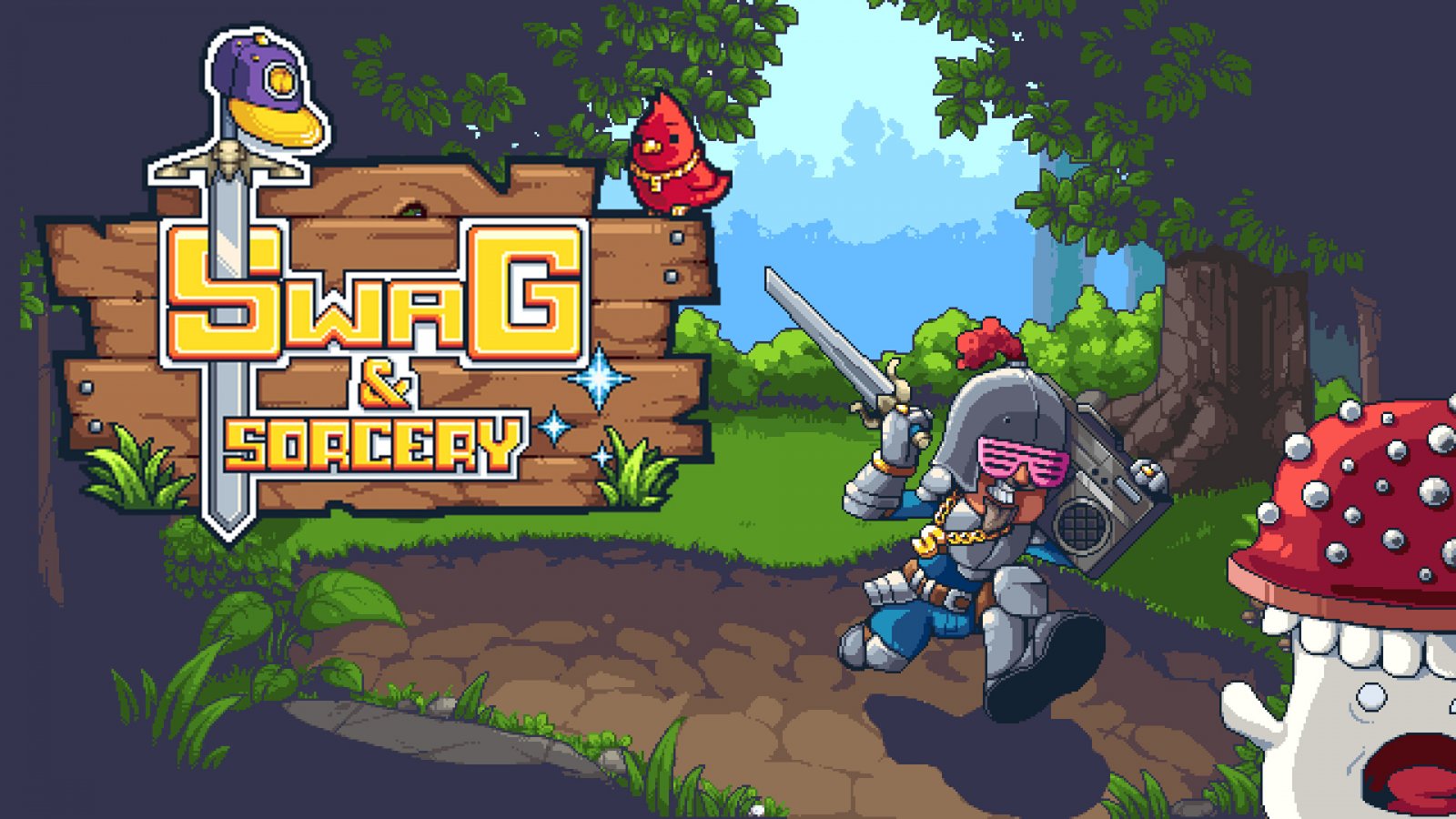Edited by: Jade Swann
Swag and Sorcery is a new title developed by the indie studio Lazy Bear Games, known for their previous two titles Graveyard Keeper and Punch Club, and Uroboros Games. Their new adventure is an easy to play game that’s fun to curl up with and dedicate a few hours to looking for resources and crafting bigger and better tiers of items and buildings. Unfortunately, at the end of those few hours, you’ll be ready to stand up and play something else since you’ll have seen everything.
DESIGN

The visuals of Swag and Sorcery are nothing new. The recurring theme of “stylized pixel graphics” combined with “generic medieval setting” makes an appearance once again for this little title, but unlike other games that will use pixel graphics as an excuse to skimp out on item details or simple character models, this one puts every square to good use. Characters, armor, and items all have distinct outlines and palettes that make it easy to identify what they are at a glance. Buildings have nice details and distinct designs that help differentiate between them, and the areas to explore are all separated enough in the art department to really bring out the feeling they’re meant to incur. The starting area feels hopeful and uplifting, like the beginning of a grand journey. The forest where you can find literal physical sorrow seems hollow and gloomy. The desecrated castle inhabited by monsters feels like it was lost to time, subject to the reclamation of nature and wildlife. While this isn’t a particularly impressive feature, it’s nice to see pixel art being used as an art style, as opposed to an excuse to cut the design budget.
It’s unfortunate that the music doesn’t share this trait. The tunes are forgettable, to say the least. They serve to complement the generic themes present in the title and play one after another like a CD instead of changing to fit the scenario you’re in. None of the music you’ll hear will leave a lasting impression on you, more so it will most likely burn itself into the back of your mind while you’re slaving away at expanding your village.
EXPAND THE TOWN
You start with a small village that only houses an adventurer’s guild. As you gather resources and collect items, you’ll be able to craft more stations, which in turn will craft more items. Your run-of-the-mill fantasy settings like the smithy and hunting lodge can create armor and weapons, locations like libraries can create spells, laboratories can put potions together, etc. But to expand and create these new additions to your town requires sending your adventurers out on quests to gather materials. The problem with these quests is that they’re glorified random encounters that randomly determine what kind of material your character will gather, or what kind of monster they will fight. This means that it can take several quests to find objects you need to advance. An average quest takes anywhere between thirty seconds to five minutes, which means that finding that piece of wood you need to craft the stuff you’ve been looking forward to will become a grueling time sink when you’re starting in a new area you’ve unlocked.

This problem is compounded by the hurdle that comes with every new area: stronger enemies. The difficulty gap is large between new locations, and enemies can one shot your characters armed only with armor made from the findings of your previous encounters. This means even more grinding in previous areas to make enough money to level up your characters to be able to forage for new objects to create new armor to ease the pain of traversing unfamiliar lands.
Even with four characters (half the available roster), it’s hard to make enough gold to buy resources to progress. Quests give minimal gold, so the primary income is crafting and selling equipment. This locks the player into a vicious cycle of quest, craft, sell, quest until you gain enough gold to beef your fellas into a state where they don’t have to worry about being wiped out by the first monster of a new area. The silver lining in all of this is the rare craft. Every time you craft an item, there’s a chance to create a special item, outlined in green. This item is stronger than normal items and can be a huge foothold in climbing the wall of grind. The only alternative to roughing it in the wild for resources are fashion shows.
THE SWAG
Fashion shows put the “swag” into Swag and Sorcery. Once you build a structure known as the fashion house, you’ll receive the occasional invitation to take part in a town-wide fashion show. During this part, you pick three of your sleekest, fleekest, dressed-freakiest characters, dress them up, and then enter them to be judged against another team of three. The top three scores win prizes depending on their place. You can bribe the judges to learn their preferences and increase your chances of winning. If you bribe them with a leather jacket, for instance, you’ll learn their feelings about leather materials, the color brown, and any other category that article might lie in. Say you give the town cook a metal helmet; you might learn that they hate metal, like the military style, and feel indifferent about the color gray. While creating one of every item to give to each judge might seem profitable since you’d eventually create a profile and know what you need to send out to win, the judges are constantly cycled out with new ones, requiring new bribes. In the end, this is just another resource sink that’s required to make use of one of the key features of the game and is incredibly frustrating.
SOME THOUGHTS

At the end of the day, Swag and Sorcery needs a tune up. Make the items easier to find by giving the player the ability to send parties out to hunt specific monsters or mine specific resources. Umbrella areas that hold all the resources and distribute them based on luck aren’t working and only slow the game down. Make the fashion show judges easier to bribe, or at least don’t make me have to cook up another batch of sacrifices for every new judge. This title has potential that’s being held back by a number generator that needs to be controlled for the experience to become enjoyable. As it is, Swag and Sorcery’s only redeeming quality is the ability to easily learn the mechanics, even for beginners of this type of game. On the flip side, this is its weakness. You’ll see everything this game has to offer after an hour or two and quickly become bored.
The Verdict: Fair
Too much RNG. Maybe you’ll find that resource you need. Maybe you’ll encounter that monster you need to fight. Maybe you’ll craft a higher quality item. That’s bad for a game genre that commonly relies on the skill and consistency of the player and its environment. Swag and Sorcery has about as much value as the word swag. While it’s easy to pick up and nice to relax with, it quickly becomes stale after an hour or two.


